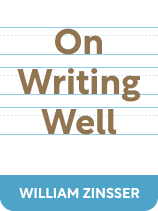

This article is an excerpt from the Shortform book guide to "On Writing Well" by William Zinsser. Shortform has the world's best summaries and analyses of books you should be reading.
Like this article? Sign up for a free trial here .
Do you struggle to keep consistent as you write? What are some things to consider to ensure your writing is consistent in terms of tone, argument, point of view, and tense?
If you want to maintain consistency in your writing, you need to ask yourself these four guiding questions: What’s the main idea? What point of view will you use? What tense will you use? And what tone will you have? You must make these decisions ahead of time so you don’t lose focus part-way through.
Here’s how to maintain consistency while writing.
What Is Consistent Writing?
Being consistent will help you write with clarity. Consistent writing is when certain key elements of your writing stay the same throughout your writing, even as your idea develops. For example, tone is one key element to keep consistent in a piece of writing, as we’ll discuss. In his book On Writing Well, William Zinsser believes consistency eliminates unwanted confusion because your reader won’t have to keep up with unnecessary changes in your writing.
Zinsser explains that while you can take some artistic liberty with your writing, you have to stick with whatever decisions you make. As you write, you can change your mind, but make sure that change is reflected throughout the rest of your writing. For example, you may start writing a piece in third person, only to decide midway through that you think first person would work better. It’s okay to change your mind, but be sure to go back and change the parts you’ve already written in third person to first person.
Zinsser discusses four decisions you should make to ensure you’re consistent. These decisions are your promise to the reader that you won’t try to confuse or trick them. To ensure you stay consistent in your artistic decisions, ask yourself these four guiding questions:
1. What’s Your Main Idea?
Zinsser believes that to bring clarity to your writing, the most important question you should ask yourself is, “What’s the main idea?” Your main idea is the most important takeaway from a piece—it’s your whole reason for writing that specific story.
Zinsser explains that your main idea will guide your writing and prevent unrelated tangents. When you have a clear main idea, all of the creative decisions you make will focus on clearly communicating it. This doesn’t mean you can’t explore other ideas in your piece, but those ideas should support your main point.
Zinsser contends that you’ll be better off writing in-depth about a specific idea than writing vaguely about a broader topic. You’ll have more space to explore details and discuss the topic thoroughly. So when deciding your main idea, be more specific than you think you need to be.
For example, imagine a writer who wants to write about life in New York City. Following Zinsser’s advice, he narrows his focus to writing about life in the Bronx in New York City. He narrows it further to one neighborhood in the Bronx. Finally, he narrows it to one family in the neighborhood. By taking a specific focus, he’ll be able to write a more realistic description of their lives. In doing so, he’ll reveal more about life in New York City than if he tried to write more broadly about the many different experiences of people living there.
2. What Point of View Will You Use?
The next clarifying question you should ask yourself is, “What point of view will I use?” Your point of view is how you narrate your piece. Your point of view establishes a relationship with the reader since it’s how you’ll refer to yourself throughout the story.
There are three points of view: first, second, and third person.
- First person uses self-referential pronouns, such as “I” and “we.” In first person, the writer is an active participant in the story since her observations are included.
- Second person uses pronouns like “you.” In second person, the writer is more removed from the story than in first person.
- Third person uses pronouns like “he,” “she,” and “they.” In third person, the writer is the most removed from the story, acting as an observer rather than a participant.
Whatever point of view you decide on, make sure it’s consistent throughout your piece so your reader doesn’t question your reliability as a narrator. If you switch points of view in your writing, you’ll confuse your reader. For example, if your friend Beth emails you about her trip to the beach and says, “I had such a great time! The water was freezing, but Beth still went swimming,” it would be confusing as she switches from first person (“I had such a great time!”) to third person (“Beth went swimming”).
3. What Tense Will You Use?
Next, create clarity by deciding what tense you’ll write in and using that tense consistently throughout your piece. Zinsser notes that tenses help your reader situate themselves in the timeline of events.
Zinsser discusses the two most common tenses: past and present.
- Past tense discusses events that happened in the past. Write in past tense when you’re looking back on an event. For example, “I walked to the store,” or “Lauren turned to Joe and asked him a question.”
- Present tense discusses events in the current moment. Use present tense when you’re writing about things as they’re happening. For example, “I’m walking to the store,” or “Lauren turns to Joe and asks him a question.”
(Shortform note: Although Zinsser doesn’t discuss it, there is also the future tense, which discusses events that haven’t—but are expected—to happen. In English, our version of future tense uses “will” and a verb, such as in, “I will go to the store.”)
Zinsser explains that you should choose one main tense to tell your story, and use different tenses as appropriate. For example, if you’re telling a story using present tense and someone tells the narrator (in the present) about a story that happened to them (in the past), writing in a different tense for this dialogue is warranted.
But, if you switch your primary tense, you’ll confuse your reader because they won’t be sure of the chronology of events. Using the example from the previous section, let’s say Beth wrote, “I had such a great time! The water is freezing, but I’m still swimming.” At first she speaks in past tense, and then she switches to present tense. Switching the second sentence to present tense throws off the logic of Beth’s story.
4. What Tone Will You Have?
Finally, your tone will affect the clarity of your writing. Zinsser explains that tone signals what you think or how you feel about your topic. For example, you could take a lighthearted, nostalgic, or formal tone toward your writing.
(Shortform note: While tone signals your attitude toward a topic, your tone can also contribute to how the reader feels from reading your piece. So tone is important not only for reader understanding but also for reader response.)
Zinsser advises keeping your tone consistent throughout a piece of writing to eliminate confusion. If the reader doesn’t know how you feel about a subject, she’ll be confused by your writing. Thus avoid switching between tones in your piece. For example, if a journalist wrote about a devastating tsunami and switched from a serious, concerned tone to a light, humorous one within that piece, he’d get backlash from confused readers.

———End of Preview———
Like what you just read? Read the rest of the world's best book summary and analysis of William Zinsser's "On Writing Well" at Shortform .
Here's what you'll find in our full On Writing Well summary :
- A back-to-basics approach to the craft of writing
- How to practice simple, clear, and engaging writing—even if you're not a writer
- How to effectively put your ideas into words






